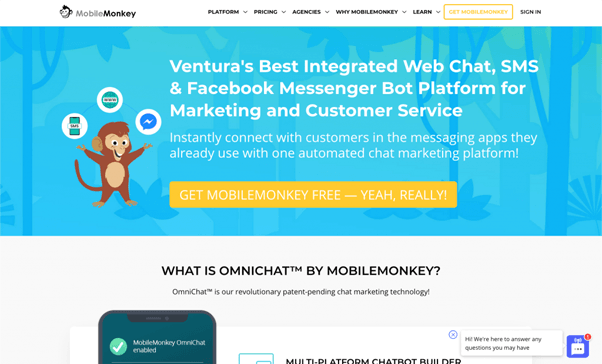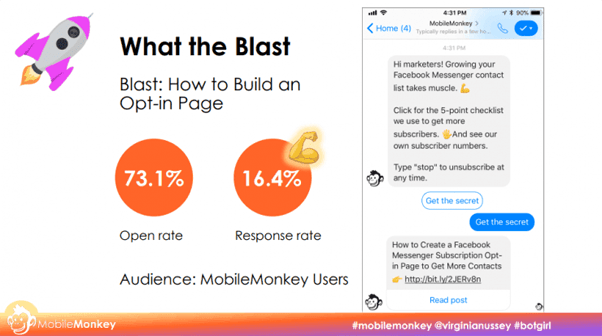How To Use Facebook Messenger for Business Growth
In 2020, your business has more reason than ever to use Facebook Messenger to engage with customers.
More than 1.5 billion people use Facebook Messenger to communicate and interact with businesses.
But with less than 1% getting on board, you can get ahead right away by making this channel available to your customers.
Business messages sent through Messenger can expect an open rate of 70 to 80%, which is around 50% more than email.
Combined with chatbots, Messenger as a marketing channel brings unicorn engagement in a world full of donkey indifference.
Facebook Messenger Chatbots for Business
Chatbots make Facebook Messenger for business more efficient and convenient for engaging with customers. Around 55% of consumers express interest in being able to interact with a business using messaging apps.
As your business grows, you want to be able to keep up with them, which is what a chatbot lets you do without pause.
The automation that a chatbot gives you also opens the door to a myriad of capabilities for extending your reach.
A chatbot can make customer service a whole lot easier, but it can do a whole lot more outside of responding to inquiries.
You can have the chatbot send chat blasts to contacts, run Messenger ads, set up Facebook post autoresponders, run drip campaigns, and so on.
Performance can also be tracked by the chatbot, letting you understand how you should run your business chat.
1. Build a Chatbot
With a chatbot like MobileMonkey, you can build a chatbot in less than five minutes with no coding at all using its easy-to-use chatbot builder.

MobileMonkey has chatbot marketing automation that lets you increase brand visibility and connect to customers through Facebook Messenger.
It also has OmniChat® technology that lets you see and respond to messages from Messenger, web chat, SMS, and other messaging apps in one platform.
You get widgets and a drag-and-drop interface that lets you use images, videos, GIFs, questions, polls, forms, text, and so on.
One of the first things you need to do is to create a custom greeting in your chatbot to welcome people who hit up your page.
The chatbot gathers information from the person through their Facebook profile as they’re added into your contact list.
It can also use that welcome message to know a bit about the person, like asking them about what they’re looking for.
That information can then be used to create custom audiences, which lets you further tailor your messages.
If you’re just starting out, you can use one of the many templates available in MobileMonkey to kickstart your Messenger chatbot.
Pick the one that suits your goals, tweak it to fit your needs, and off you go.
2. Chat Blasts
Chat blasts are similar to email blasts in both purpose and execution, but the former is a lot more effective.
They have much higher open rates at 70 to 80% due to Messenger being a lot more engaging, especially for mobile users.
They’re automated when done through a chatbot, and it can be sent whenever you do something like publish a new blog post.
You can set up a chat blast in less than five minutes, which you can then send to your Facebook Messenger contacts.

3. Messenger Ads
Facebook Messenger ads are one of the most powerful digital marketing tools available in 2020 due to the advent of chat marketing.
They do better than regular Facebook ads as they create engaging conversations with chatbots, performing two to ten times better.
There are two types of Messenger ads that exist, namely Click to Messenger ads and sponsored messages.
Messenger ads can take you across other places as well, like the Facebook newsfeed, instagram feed, Facebook and Instagram Stories, and Marketplace.
Unlike regular ads, Messenger ads lead to conversation between the prospect and your business, letting you nurture your leads right away.
You can also capture their data, letting you learn more about your audience and create segments to hone in your marketing.
Through your chatbot, you can personalize your Messenger ads and automate lead qualification and nurturing.
4. Facebook Post Autoresponder
To make your Messenger marketing more effective, you need to invest more in growing your contact list.
Lead magnets are good for that, and one of the best lead magnets out there is the Facebook post autoresponder.
Also known as a Comment Guard, it lets your chatbot message anyone who comments on a Facebook post it has been set up in.
This is done best in Facebook posts that tend to attract a lot of engagement, like something that asks your audience a question.
Have them guess the right answer to the question in the comments, then have your chatbot set up an autoresponder for that post.
Your chatbot should then auto-send a response in Messenger to tell them if they’re right or wrong, and take it from there.
If engagement in that post is above average, you can maximize it further by boosting that post to get more impressions.
The better the engagement, the more visible the post becomes, which can then yield even more engagement.
With that, the more it generates leads as your chatbot messages more commenters.
5. Drip Campaign
MobileMonkey is capable of running drip campaigns in Messenger, web chat, SMS, and other messaging platforms.
A drip campaign is basically a sequence of messages sent at specific time intervals to market a product or brand.
It can be used to welcome and onboard customers, nurture leads, make use of sophisticated solutions, and scale automated communications.
Drip campaigns have always been around in email, but Messenger takes them to the next level with higher open rates and better engagement.
You only need to create a drip campaign once, and you can use them to keep customers engaged by sending them content that interests them.
6. Customer Support Chatbot
Live web chat alone is very limited compared to one with a chatbot, especially with omnichannel capabilities.
For instance, MobileMonkey’s OmniChatⓇ technology connects you with customers from not just your web chat, but also Messenger, SMS, and so on.
With Messenger integration, your conversations are tied to customer profiles, as well as chat history that provides a rich source of information.
That information can guide your business decisions, thus greatly helping the growth of your brand.
That omnichannel integration also means conversations can be had from desktop, mobile, and other platforms.
If a website visitor who wishes to talk doesn’t use Messenger, MobileMonkey OmniChat can be set up to let them do so without any login.
A chatbot can reduce customer service costs while providing the same capability as a large customer support team.
But combined with human operators, it makes for the ultimate customer support team that can handle tons of inquiries.
If a chatbot encounters an issue that it doesn’t have answers for, a human operator can do live chat takeover to tackle it.
And of course, whenever someone hits you up on Messenger, they get added to your contact list and you can then market to them later on.
7. Chatbot Analytics
Knowing who you’re talking to isn’t just about paying attention to your chat, but also looking at the numbers.
Paying attention to your chatbot analytics can help you better understand your audience by seeing what metrics are being affected.
Look at the combination of data, notes, tags, chat histories, attributes, and variables to come up with your ideal customer profile.
You can then create audience segments that you can use to really target your customers and boost conversions.
Key areas you can focus on are traffic insights, product opportunities, missed opportunities, frequently asked questions, and customer support data.
Combine chatbot analytics with Facebook Messenger data to create personalized campaigns, which you can manage through OmniChat.
8. Build Email Lists
While chat marketing is indeed more effective, email marketing still has its place in your digital marketing strategy.
After all, you would want to hedge your bets, and email marketing can still work wonders when done right.
Therefore, you should build your email list, and you can do that more easily with your Messenger chatbot.
When you add people to your contact list, you get their information, including their email addresses.
All you need to do is to deploy lead magnets that can bring them in, letting you collect their contact information easily.
